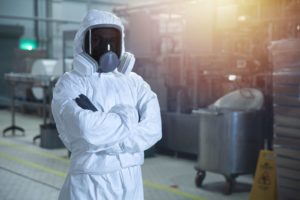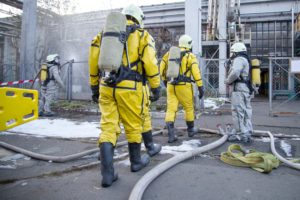Effective Respiratory Protection: How to Choose a Suitable Respirator

For those familiar with the Hierarchy of Controls developed by the National Institute for Occupational Safety and Health (NIOSH) to determine the most effective control measures to be adopted in the workplace, you will also realize that respirator protection falls within the purview of personal protective equipment (PPE). However, while PPE may be considered as the last level for the protection of the health and safety of workers, respirators and other types of PPE are still widely used across industries to safeguard the health of workers working with hazardous substances. Furthermore, according to OSHA, any employer (workplace) requiring employees to use respirators for protection from fumes, dusts, gases, smoke, low oxygen levels, etc., must comply with OSHA’s Respiratory Protection Standard 29 CFR 1910.134.
Today, the COVID-19 pandemic has made respiratory protection still more widespread. Now, not only do workers across industries exposed to hazardous materials, dangerous chemicals, and other non-conducive safe breathing environments require respiratory protection, but so do the public who have never once considered wearing a facemask before the year 2020. In fact, the general awareness of respiratory protection has considerably increased in this pandemic year, and with it, the utter chaos and confusion as to the types of facemask and/or respirators to use for optimal protection.
So, how do we choose the “right” type of respirator dependent on factors such as personal health levels, occupations, and exposure to hazardous atmospheres? Read on and learn more.
Choosing the Right Type of Facemask to Protect Against COVID-19
 |
||||
| Fabric Masks | Surgical/Medical Masks | N95 Masks or Filtering Facepiece (FFP) | ||
|---|---|---|---|---|
| Made of cotton or synthetic fabric, maybe one, two, or three layers. | Made of three layers of synthetic nonwoven materials with filtration layers sandwiched in the middle. | Uses an electrostatic filter to capture particles, including viruses. Some N95-masks have valves. | ||
| Degree of Protection | Protects others from the wearer's respiratory emissions and offers the wearer some protection. | Protects others from the wearer's respiratory emissions and offers the wearer some protection. | Protects others from respiratory emissions and reduces wearer's exposure to particles. | |
| Effectiveness | Ranges between 26% to 80% depending on the type of fabric used and the number of layers. | Greater protection than fabric masks but lower protection than an N95 mask or equivalent. | The N95 mask is 95% effective in blocking both small and large particles. | |
| Breathability | If made of cotton fabric breathing would not be a problem, but a synthetic fabric may cause difficulty and feel hot. | Breathable | Would require some practice and getting used to. Breathing may be difficult. | |
| Area Covered | Nose and Mouth | Nose and Mouth | Nose and Mouth | |
| Fit | Can be either tight-fitting or loose-fitting | Loose-fitting | Tight-fitting, creates a seal | |
| Reusability | Washable and reusable | Single-use | Single-use or reusable (depends on the type being used) | |
| WHO Recommendation | A three-layer structure | For healthcare workers, people with Covid-19 symptoms, those coming into contact with them, anyone aged 60 or over, or vulnerable individuals. | For healthcare workers taking part in high-risk, aerosol-generating procedures. | |
Types of Respirators Available to Protect Workers from Hazardous Atmospheres and Environments in the Workplace
For employees who must work in areas that have hazardous atmospheres or are at risk of exposure to airborne contaminants from chemicals, radioactive materials, or biological substances, require a higher level of respiratory protection according to OSHA. As such, employers are required to develop a comprehensive Respiratory Protection Program, provide workers with the right fit respirator, and train them on the correct use of these respirators.
Below are the two main types of respirators available for use by such workers.

Air-Purifying Respirators (APRs)
These types of respirators filter the air that is breathed in from the environment. APRs are further categorized as below:
| Type of Respirators | Description |
|---|---|
| Particulate-Removing APRs | They use particulate filters to remove dusts, fumes, mists, toxic dusts, asbestos-containing fibers, or a combination of these from the air being breathed by workers. NIOSH has given 10 different classifications for particulate filters, with each designed for a specific type of airborne contaminant at a particular efficiency rating. |
| Gas and Vapor Removing APRs | These are designed with canisters and cartridges that trap the gas and vapors from a hazardous environment before they can enter the workers’ respiratory tract. Different types of canisters and cartridges are used to trap different types of gases and vapors. |
| Combination Cartridge/Filter APRs | These types of respirators protect against both particulates as well as gases and vapors. Based on the types of hazards in the atmosphere, different combinations of particulate and gas/vapor cartridges have to be used. |
 Air-Supplying Respirators (ASRs)
Air-Supplying Respirators (ASRs)
These types of respirators pump fresh air into the facepiece that is not inhaled from the outside. This means that these respirators have an attached oxygen tank from which air is breathed. ASRs are further categorized as: Self-Contained Breathing Apparatus (SCBA)The SCBA is the most popular type of air-supplying respirators. The SCBA contains a full-piece facemask and a canister that holds the oxygen from which the wearer of the SCBA unit gets his/her breathing air. The canisters are worn on the back. The SCBA equipment can be very heavy, sometimes around 30 pounds, and it requires special training to use.
| Type of Respirators | Description |
|---|---|
| Supplied-Air Respirators (SARs) | SARs, also known as airline respirators, receives air from a connecting hose and a distant cylinder or air compressor. So, workers do not have to carry their air on their backs. |
Besides, respirators can also be classified as tight or loose-fitting, positive or negative pressure, demand or pressure-demand airflow, entry and escape vs. escape only, and open or closed-circuit respirators.
Online Training for Workers
For those of you who are employed in hazardous waste operations or in industries where the risk of atmospheric contamination or exposure to chemicals is high, information on respiratory protection is part of the training given in the relevant OSHA-compliant online training programs. So, review our course list and enroll in the training that best suits you. However, our OSHA 40-Hour HAZWOPER Training course provides in-depth information on respiratory protection for those who are employed in hazardous waste operations and emergency response!
Reference:
LaMotte. S. (2021, January 26). COVID-19 masks: Which mask is best for you, and when to use it? CNN. Website. https://edition.cnn.com/2021/01/25/health/covid-19-masks-which-is-best-wellness/index.html



